INOR6026 - Neo-Classical Economics: Analysis of Single Owner Firms
VerifiedAdded on 2023/04/05
|9
|2755
|149
Essay
AI Summary
This essay delves into the neo-classical theory of the firm, focusing on the assumption of single-owner businesses and their implications. It discusses the prevalence of family-owned firms, highlighting factors such as long-term management, substitution, family values, transparency, and profit retention. The essay examines the implications of family-owned businesses on governance and control, including value creation, appropriation of private benefits, informal work environments, lack of succession plans, and exposure to risk. It also considers the impact of government rules and regulations, such as corporate and securities law, environmental law, employment law, and health insurance regulations, on these businesses. The analysis reveals potential conflicts and challenges associated with family-owned firms, particularly concerning value creation for all shareholders and the balance between family interests and business objectives.
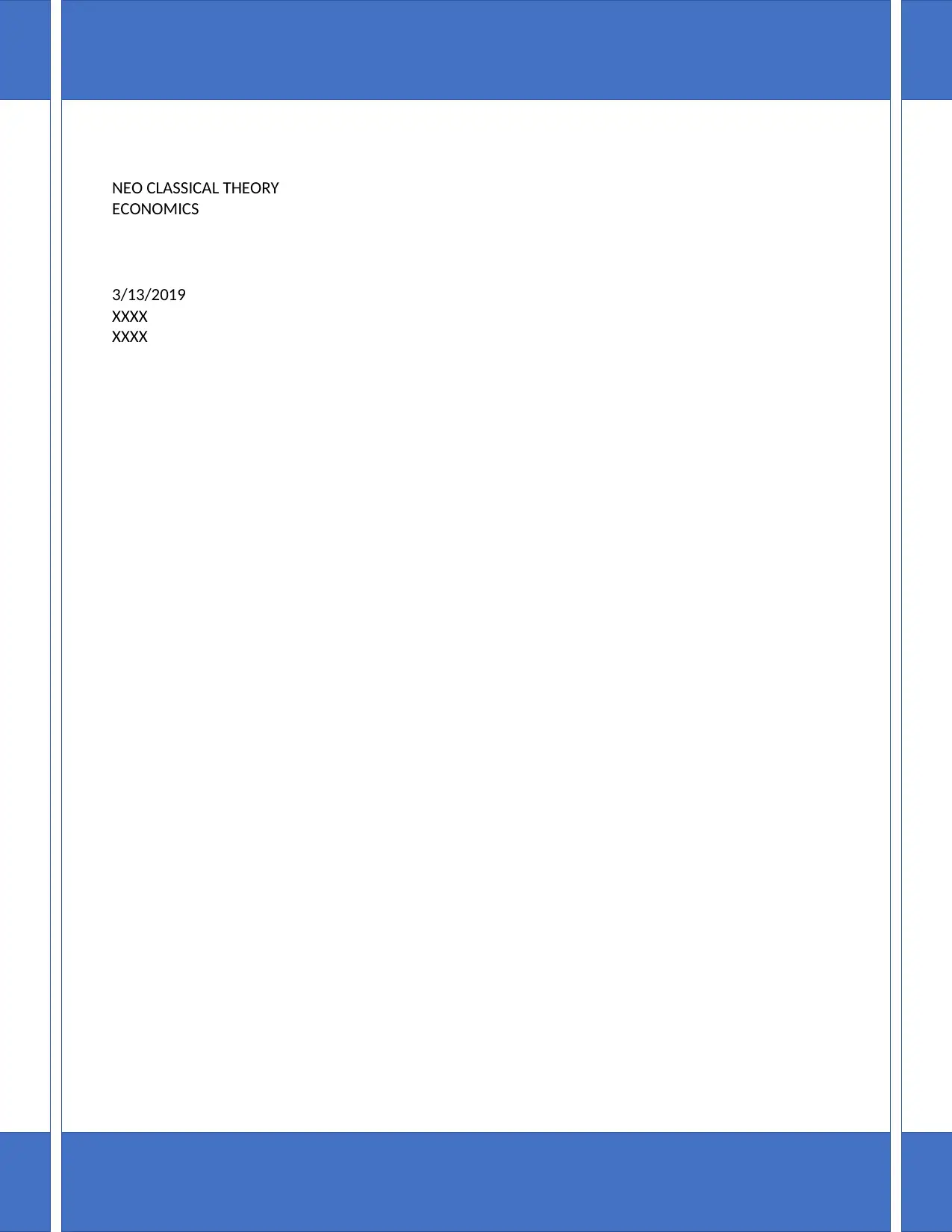
NEO CLASSICAL THEORY
ECONOMICS
3/13/2019
XXXX
XXXX
ECONOMICS
3/13/2019
XXXX
XXXX
Paraphrase This Document
Need a fresh take? Get an instant paraphrase of this document with our AI Paraphraser
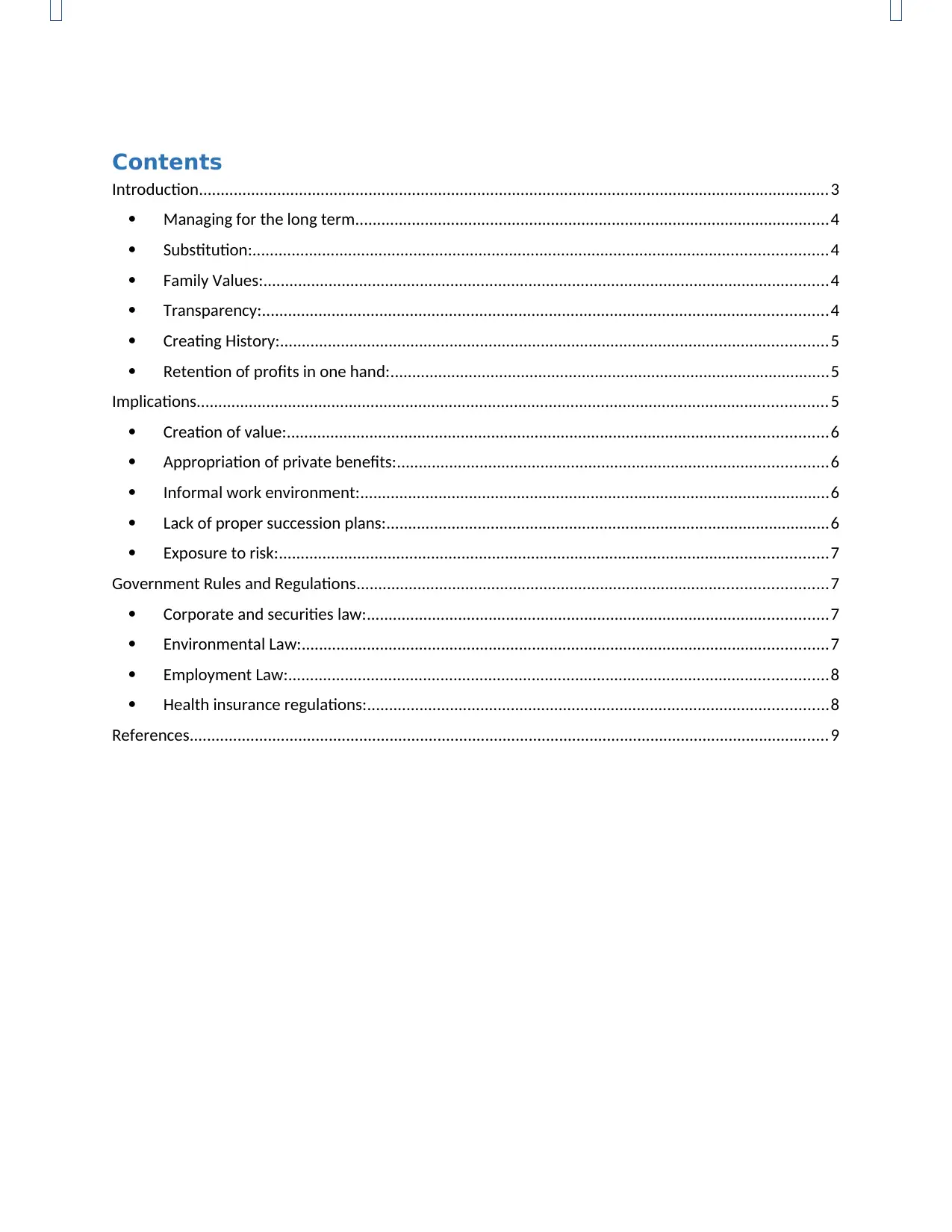
Contents
Introduction.................................................................................................................................................3
Managing for the long term.............................................................................................................4
Substitution:....................................................................................................................................4
Family Values:..................................................................................................................................4
Transparency:..................................................................................................................................4
Creating History:..............................................................................................................................5
Retention of profits in one hand:.....................................................................................................5
Implications.................................................................................................................................................5
Creation of value:............................................................................................................................6
Appropriation of private benefits:...................................................................................................6
Informal work environment:............................................................................................................6
Lack of proper succession plans:......................................................................................................6
Exposure to risk:..............................................................................................................................7
Government Rules and Regulations............................................................................................................7
Corporate and securities law:..........................................................................................................7
Environmental Law:.........................................................................................................................7
Employment Law:............................................................................................................................8
Health insurance regulations:..........................................................................................................8
References...................................................................................................................................................9
Introduction.................................................................................................................................................3
Managing for the long term.............................................................................................................4
Substitution:....................................................................................................................................4
Family Values:..................................................................................................................................4
Transparency:..................................................................................................................................4
Creating History:..............................................................................................................................5
Retention of profits in one hand:.....................................................................................................5
Implications.................................................................................................................................................5
Creation of value:............................................................................................................................6
Appropriation of private benefits:...................................................................................................6
Informal work environment:............................................................................................................6
Lack of proper succession plans:......................................................................................................6
Exposure to risk:..............................................................................................................................7
Government Rules and Regulations............................................................................................................7
Corporate and securities law:..........................................................................................................7
Environmental Law:.........................................................................................................................7
Employment Law:............................................................................................................................8
Health insurance regulations:..........................................................................................................8
References...................................................................................................................................................9
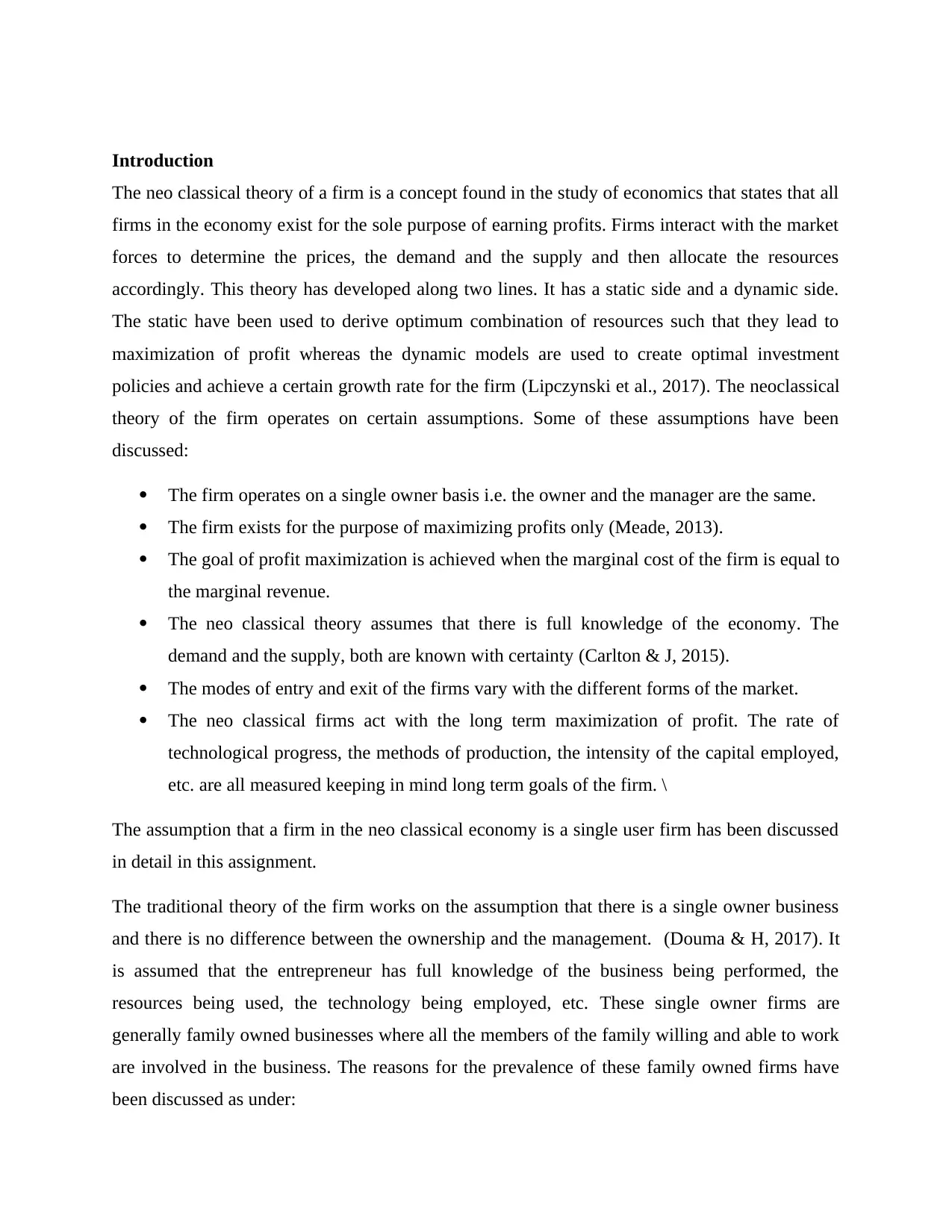
Introduction
The neo classical theory of a firm is a concept found in the study of economics that states that all
firms in the economy exist for the sole purpose of earning profits. Firms interact with the market
forces to determine the prices, the demand and the supply and then allocate the resources
accordingly. This theory has developed along two lines. It has a static side and a dynamic side.
The static have been used to derive optimum combination of resources such that they lead to
maximization of profit whereas the dynamic models are used to create optimal investment
policies and achieve a certain growth rate for the firm (Lipczynski et al., 2017). The neoclassical
theory of the firm operates on certain assumptions. Some of these assumptions have been
discussed:
The firm operates on a single owner basis i.e. the owner and the manager are the same.
The firm exists for the purpose of maximizing profits only (Meade, 2013).
The goal of profit maximization is achieved when the marginal cost of the firm is equal to
the marginal revenue.
The neo classical theory assumes that there is full knowledge of the economy. The
demand and the supply, both are known with certainty (Carlton & J, 2015).
The modes of entry and exit of the firms vary with the different forms of the market.
The neo classical firms act with the long term maximization of profit. The rate of
technological progress, the methods of production, the intensity of the capital employed,
etc. are all measured keeping in mind long term goals of the firm. \
The assumption that a firm in the neo classical economy is a single user firm has been discussed
in detail in this assignment.
The traditional theory of the firm works on the assumption that there is a single owner business
and there is no difference between the ownership and the management. (Douma & H, 2017). It
is assumed that the entrepreneur has full knowledge of the business being performed, the
resources being used, the technology being employed, etc. These single owner firms are
generally family owned businesses where all the members of the family willing and able to work
are involved in the business. The reasons for the prevalence of these family owned firms have
been discussed as under:
The neo classical theory of a firm is a concept found in the study of economics that states that all
firms in the economy exist for the sole purpose of earning profits. Firms interact with the market
forces to determine the prices, the demand and the supply and then allocate the resources
accordingly. This theory has developed along two lines. It has a static side and a dynamic side.
The static have been used to derive optimum combination of resources such that they lead to
maximization of profit whereas the dynamic models are used to create optimal investment
policies and achieve a certain growth rate for the firm (Lipczynski et al., 2017). The neoclassical
theory of the firm operates on certain assumptions. Some of these assumptions have been
discussed:
The firm operates on a single owner basis i.e. the owner and the manager are the same.
The firm exists for the purpose of maximizing profits only (Meade, 2013).
The goal of profit maximization is achieved when the marginal cost of the firm is equal to
the marginal revenue.
The neo classical theory assumes that there is full knowledge of the economy. The
demand and the supply, both are known with certainty (Carlton & J, 2015).
The modes of entry and exit of the firms vary with the different forms of the market.
The neo classical firms act with the long term maximization of profit. The rate of
technological progress, the methods of production, the intensity of the capital employed,
etc. are all measured keeping in mind long term goals of the firm. \
The assumption that a firm in the neo classical economy is a single user firm has been discussed
in detail in this assignment.
The traditional theory of the firm works on the assumption that there is a single owner business
and there is no difference between the ownership and the management. (Douma & H, 2017). It
is assumed that the entrepreneur has full knowledge of the business being performed, the
resources being used, the technology being employed, etc. These single owner firms are
generally family owned businesses where all the members of the family willing and able to work
are involved in the business. The reasons for the prevalence of these family owned firms have
been discussed as under:
⊘ This is a preview!⊘
Do you want full access?
Subscribe today to unlock all pages.

Trusted by 1+ million students worldwide
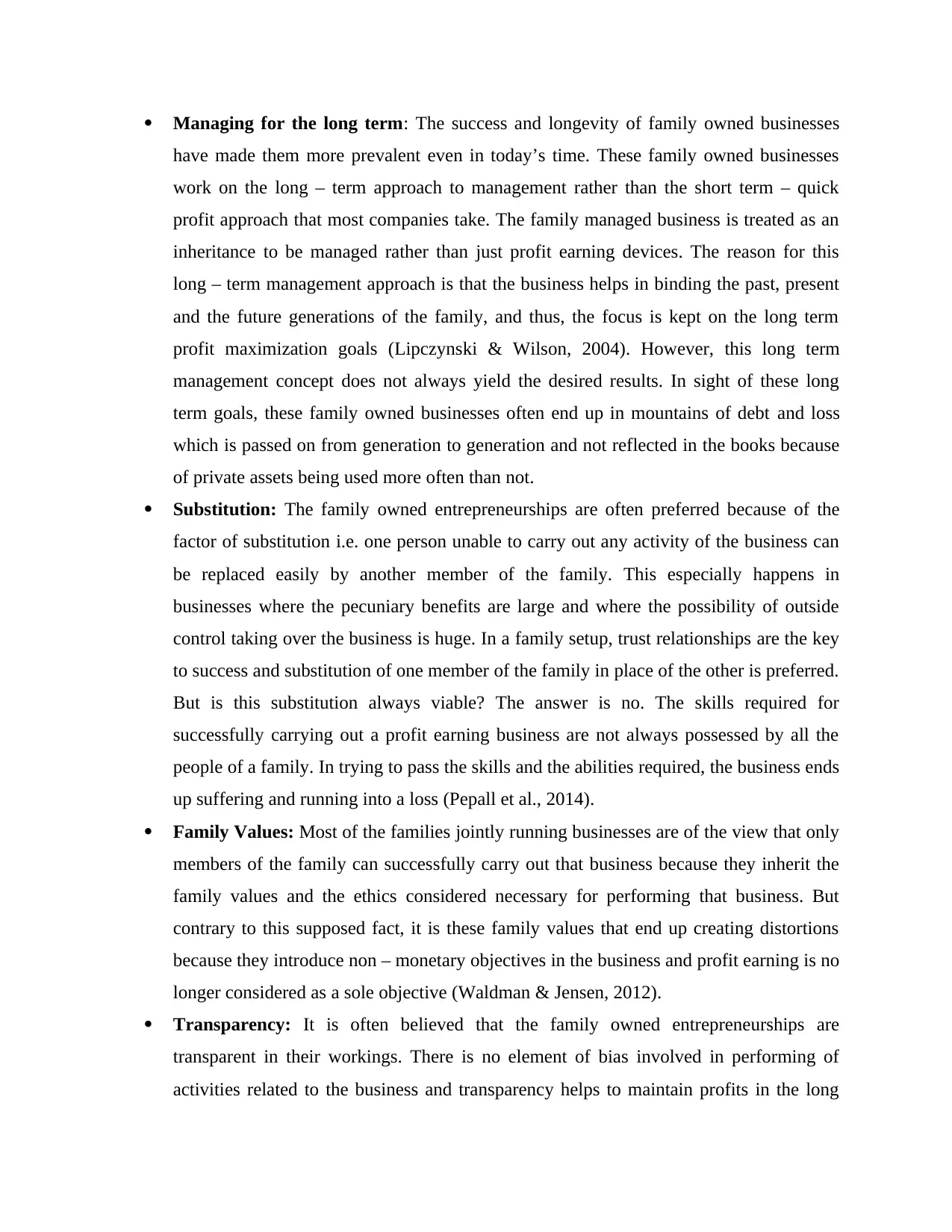
Managing for the long term: The success and longevity of family owned businesses
have made them more prevalent even in today’s time. These family owned businesses
work on the long – term approach to management rather than the short term – quick
profit approach that most companies take. The family managed business is treated as an
inheritance to be managed rather than just profit earning devices. The reason for this
long – term management approach is that the business helps in binding the past, present
and the future generations of the family, and thus, the focus is kept on the long term
profit maximization goals (Lipczynski & Wilson, 2004). However, this long term
management concept does not always yield the desired results. In sight of these long
term goals, these family owned businesses often end up in mountains of debt and loss
which is passed on from generation to generation and not reflected in the books because
of private assets being used more often than not.
Substitution: The family owned entrepreneurships are often preferred because of the
factor of substitution i.e. one person unable to carry out any activity of the business can
be replaced easily by another member of the family. This especially happens in
businesses where the pecuniary benefits are large and where the possibility of outside
control taking over the business is huge. In a family setup, trust relationships are the key
to success and substitution of one member of the family in place of the other is preferred.
But is this substitution always viable? The answer is no. The skills required for
successfully carrying out a profit earning business are not always possessed by all the
people of a family. In trying to pass the skills and the abilities required, the business ends
up suffering and running into a loss (Pepall et al., 2014).
Family Values: Most of the families jointly running businesses are of the view that only
members of the family can successfully carry out that business because they inherit the
family values and the ethics considered necessary for performing that business. But
contrary to this supposed fact, it is these family values that end up creating distortions
because they introduce non – monetary objectives in the business and profit earning is no
longer considered as a sole objective (Waldman & Jensen, 2012).
Transparency: It is often believed that the family owned entrepreneurships are
transparent in their workings. There is no element of bias involved in performing of
activities related to the business and transparency helps to maintain profits in the long
have made them more prevalent even in today’s time. These family owned businesses
work on the long – term approach to management rather than the short term – quick
profit approach that most companies take. The family managed business is treated as an
inheritance to be managed rather than just profit earning devices. The reason for this
long – term management approach is that the business helps in binding the past, present
and the future generations of the family, and thus, the focus is kept on the long term
profit maximization goals (Lipczynski & Wilson, 2004). However, this long term
management concept does not always yield the desired results. In sight of these long
term goals, these family owned businesses often end up in mountains of debt and loss
which is passed on from generation to generation and not reflected in the books because
of private assets being used more often than not.
Substitution: The family owned entrepreneurships are often preferred because of the
factor of substitution i.e. one person unable to carry out any activity of the business can
be replaced easily by another member of the family. This especially happens in
businesses where the pecuniary benefits are large and where the possibility of outside
control taking over the business is huge. In a family setup, trust relationships are the key
to success and substitution of one member of the family in place of the other is preferred.
But is this substitution always viable? The answer is no. The skills required for
successfully carrying out a profit earning business are not always possessed by all the
people of a family. In trying to pass the skills and the abilities required, the business ends
up suffering and running into a loss (Pepall et al., 2014).
Family Values: Most of the families jointly running businesses are of the view that only
members of the family can successfully carry out that business because they inherit the
family values and the ethics considered necessary for performing that business. But
contrary to this supposed fact, it is these family values that end up creating distortions
because they introduce non – monetary objectives in the business and profit earning is no
longer considered as a sole objective (Waldman & Jensen, 2012).
Transparency: It is often believed that the family owned entrepreneurships are
transparent in their workings. There is no element of bias involved in performing of
activities related to the business and transparency helps to maintain profits in the long
Paraphrase This Document
Need a fresh take? Get an instant paraphrase of this document with our AI Paraphraser
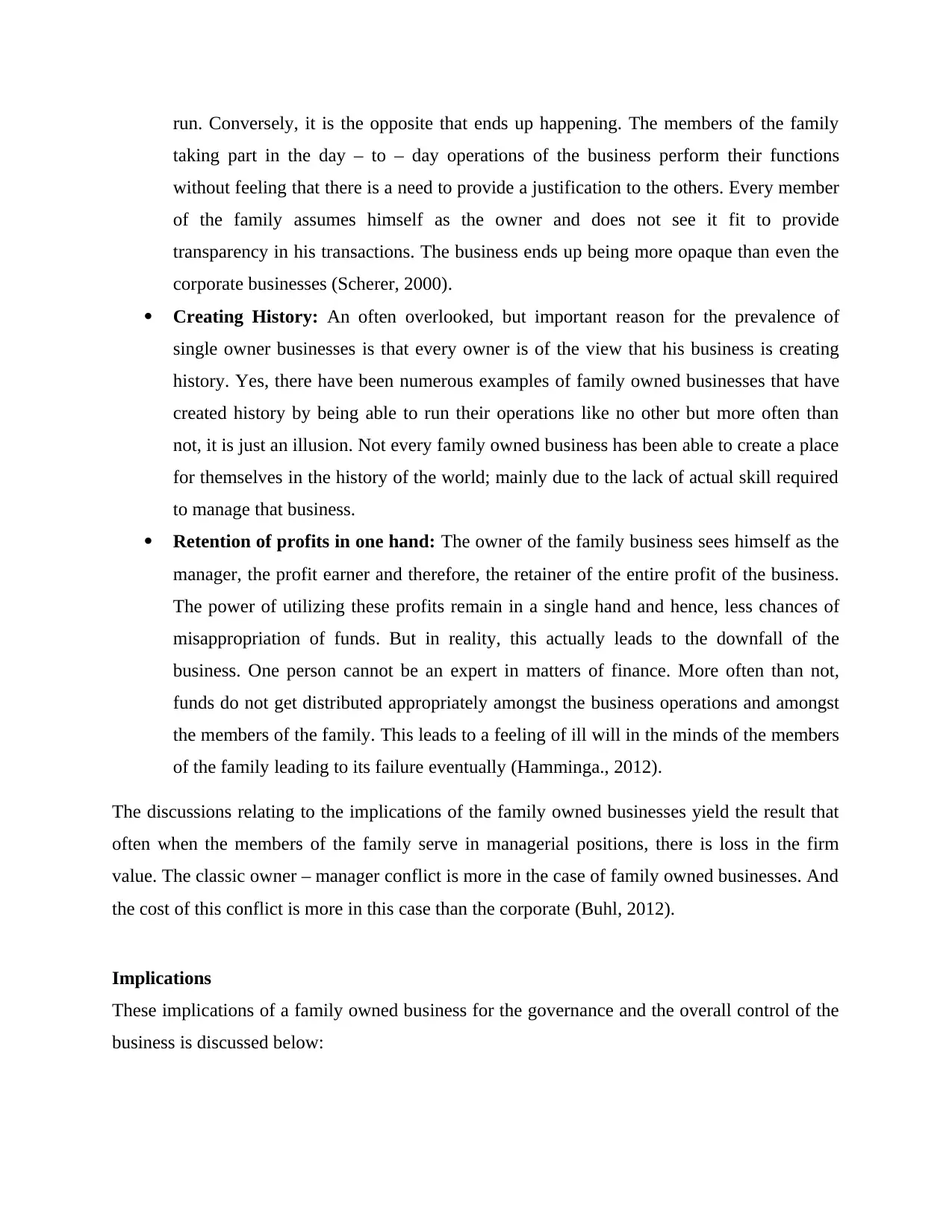
run. Conversely, it is the opposite that ends up happening. The members of the family
taking part in the day – to – day operations of the business perform their functions
without feeling that there is a need to provide a justification to the others. Every member
of the family assumes himself as the owner and does not see it fit to provide
transparency in his transactions. The business ends up being more opaque than even the
corporate businesses (Scherer, 2000).
Creating History: An often overlooked, but important reason for the prevalence of
single owner businesses is that every owner is of the view that his business is creating
history. Yes, there have been numerous examples of family owned businesses that have
created history by being able to run their operations like no other but more often than
not, it is just an illusion. Not every family owned business has been able to create a place
for themselves in the history of the world; mainly due to the lack of actual skill required
to manage that business.
Retention of profits in one hand: The owner of the family business sees himself as the
manager, the profit earner and therefore, the retainer of the entire profit of the business.
The power of utilizing these profits remain in a single hand and hence, less chances of
misappropriation of funds. But in reality, this actually leads to the downfall of the
business. One person cannot be an expert in matters of finance. More often than not,
funds do not get distributed appropriately amongst the business operations and amongst
the members of the family. This leads to a feeling of ill will in the minds of the members
of the family leading to its failure eventually (Hamminga., 2012).
The discussions relating to the implications of the family owned businesses yield the result that
often when the members of the family serve in managerial positions, there is loss in the firm
value. The classic owner – manager conflict is more in the case of family owned businesses. And
the cost of this conflict is more in this case than the corporate (Buhl, 2012).
Implications
These implications of a family owned business for the governance and the overall control of the
business is discussed below:
taking part in the day – to – day operations of the business perform their functions
without feeling that there is a need to provide a justification to the others. Every member
of the family assumes himself as the owner and does not see it fit to provide
transparency in his transactions. The business ends up being more opaque than even the
corporate businesses (Scherer, 2000).
Creating History: An often overlooked, but important reason for the prevalence of
single owner businesses is that every owner is of the view that his business is creating
history. Yes, there have been numerous examples of family owned businesses that have
created history by being able to run their operations like no other but more often than
not, it is just an illusion. Not every family owned business has been able to create a place
for themselves in the history of the world; mainly due to the lack of actual skill required
to manage that business.
Retention of profits in one hand: The owner of the family business sees himself as the
manager, the profit earner and therefore, the retainer of the entire profit of the business.
The power of utilizing these profits remain in a single hand and hence, less chances of
misappropriation of funds. But in reality, this actually leads to the downfall of the
business. One person cannot be an expert in matters of finance. More often than not,
funds do not get distributed appropriately amongst the business operations and amongst
the members of the family. This leads to a feeling of ill will in the minds of the members
of the family leading to its failure eventually (Hamminga., 2012).
The discussions relating to the implications of the family owned businesses yield the result that
often when the members of the family serve in managerial positions, there is loss in the firm
value. The classic owner – manager conflict is more in the case of family owned businesses. And
the cost of this conflict is more in this case than the corporate (Buhl, 2012).
Implications
These implications of a family owned business for the governance and the overall control of the
business is discussed below:
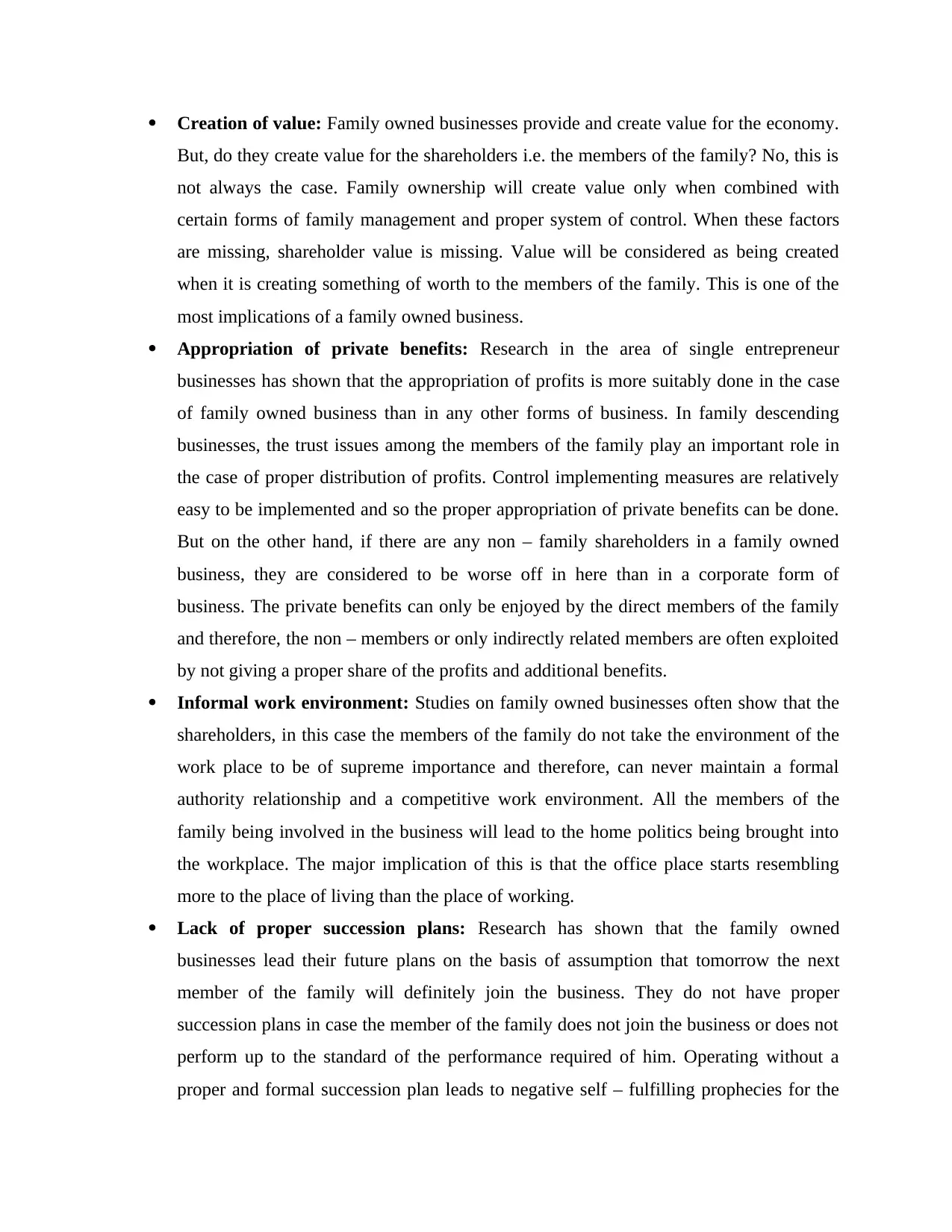
Creation of value: Family owned businesses provide and create value for the economy.
But, do they create value for the shareholders i.e. the members of the family? No, this is
not always the case. Family ownership will create value only when combined with
certain forms of family management and proper system of control. When these factors
are missing, shareholder value is missing. Value will be considered as being created
when it is creating something of worth to the members of the family. This is one of the
most implications of a family owned business.
Appropriation of private benefits: Research in the area of single entrepreneur
businesses has shown that the appropriation of profits is more suitably done in the case
of family owned business than in any other forms of business. In family descending
businesses, the trust issues among the members of the family play an important role in
the case of proper distribution of profits. Control implementing measures are relatively
easy to be implemented and so the proper appropriation of private benefits can be done.
But on the other hand, if there are any non – family shareholders in a family owned
business, they are considered to be worse off in here than in a corporate form of
business. The private benefits can only be enjoyed by the direct members of the family
and therefore, the non – members or only indirectly related members are often exploited
by not giving a proper share of the profits and additional benefits.
Informal work environment: Studies on family owned businesses often show that the
shareholders, in this case the members of the family do not take the environment of the
work place to be of supreme importance and therefore, can never maintain a formal
authority relationship and a competitive work environment. All the members of the
family being involved in the business will lead to the home politics being brought into
the workplace. The major implication of this is that the office place starts resembling
more to the place of living than the place of working.
Lack of proper succession plans: Research has shown that the family owned
businesses lead their future plans on the basis of assumption that tomorrow the next
member of the family will definitely join the business. They do not have proper
succession plans in case the member of the family does not join the business or does not
perform up to the standard of the performance required of him. Operating without a
proper and formal succession plan leads to negative self – fulfilling prophecies for the
But, do they create value for the shareholders i.e. the members of the family? No, this is
not always the case. Family ownership will create value only when combined with
certain forms of family management and proper system of control. When these factors
are missing, shareholder value is missing. Value will be considered as being created
when it is creating something of worth to the members of the family. This is one of the
most implications of a family owned business.
Appropriation of private benefits: Research in the area of single entrepreneur
businesses has shown that the appropriation of profits is more suitably done in the case
of family owned business than in any other forms of business. In family descending
businesses, the trust issues among the members of the family play an important role in
the case of proper distribution of profits. Control implementing measures are relatively
easy to be implemented and so the proper appropriation of private benefits can be done.
But on the other hand, if there are any non – family shareholders in a family owned
business, they are considered to be worse off in here than in a corporate form of
business. The private benefits can only be enjoyed by the direct members of the family
and therefore, the non – members or only indirectly related members are often exploited
by not giving a proper share of the profits and additional benefits.
Informal work environment: Studies on family owned businesses often show that the
shareholders, in this case the members of the family do not take the environment of the
work place to be of supreme importance and therefore, can never maintain a formal
authority relationship and a competitive work environment. All the members of the
family being involved in the business will lead to the home politics being brought into
the workplace. The major implication of this is that the office place starts resembling
more to the place of living than the place of working.
Lack of proper succession plans: Research has shown that the family owned
businesses lead their future plans on the basis of assumption that tomorrow the next
member of the family will definitely join the business. They do not have proper
succession plans in case the member of the family does not join the business or does not
perform up to the standard of the performance required of him. Operating without a
proper and formal succession plan leads to negative self – fulfilling prophecies for the
⊘ This is a preview!⊘
Do you want full access?
Subscribe today to unlock all pages.

Trusted by 1+ million students worldwide
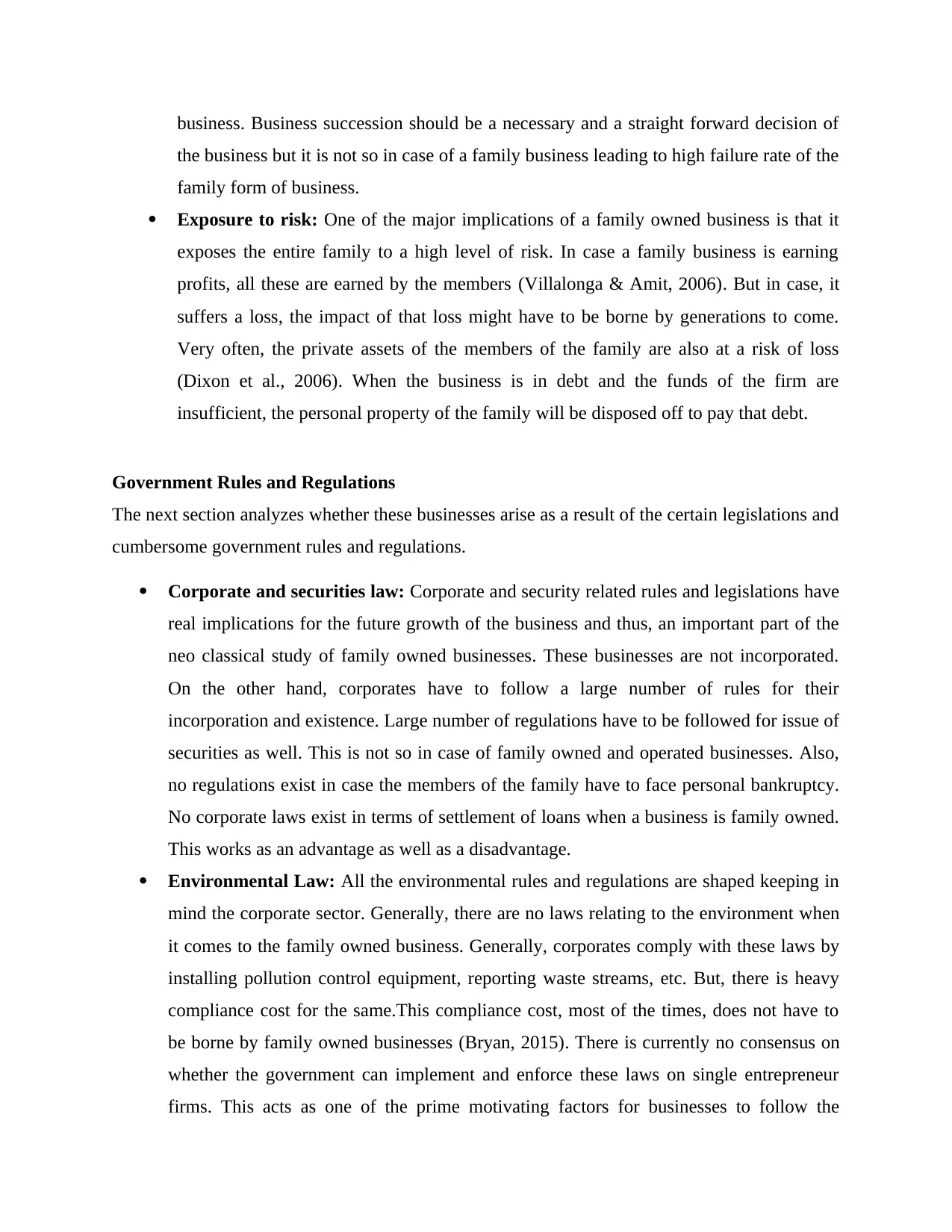
business. Business succession should be a necessary and a straight forward decision of
the business but it is not so in case of a family business leading to high failure rate of the
family form of business.
Exposure to risk: One of the major implications of a family owned business is that it
exposes the entire family to a high level of risk. In case a family business is earning
profits, all these are earned by the members (Villalonga & Amit, 2006). But in case, it
suffers a loss, the impact of that loss might have to be borne by generations to come.
Very often, the private assets of the members of the family are also at a risk of loss
(Dixon et al., 2006). When the business is in debt and the funds of the firm are
insufficient, the personal property of the family will be disposed off to pay that debt.
Government Rules and Regulations
The next section analyzes whether these businesses arise as a result of the certain legislations and
cumbersome government rules and regulations.
Corporate and securities law: Corporate and security related rules and legislations have
real implications for the future growth of the business and thus, an important part of the
neo classical study of family owned businesses. These businesses are not incorporated.
On the other hand, corporates have to follow a large number of rules for their
incorporation and existence. Large number of regulations have to be followed for issue of
securities as well. This is not so in case of family owned and operated businesses. Also,
no regulations exist in case the members of the family have to face personal bankruptcy.
No corporate laws exist in terms of settlement of loans when a business is family owned.
This works as an advantage as well as a disadvantage.
Environmental Law: All the environmental rules and regulations are shaped keeping in
mind the corporate sector. Generally, there are no laws relating to the environment when
it comes to the family owned business. Generally, corporates comply with these laws by
installing pollution control equipment, reporting waste streams, etc. But, there is heavy
compliance cost for the same.This compliance cost, most of the times, does not have to
be borne by family owned businesses (Bryan, 2015). There is currently no consensus on
whether the government can implement and enforce these laws on single entrepreneur
firms. This acts as one of the prime motivating factors for businesses to follow the
the business but it is not so in case of a family business leading to high failure rate of the
family form of business.
Exposure to risk: One of the major implications of a family owned business is that it
exposes the entire family to a high level of risk. In case a family business is earning
profits, all these are earned by the members (Villalonga & Amit, 2006). But in case, it
suffers a loss, the impact of that loss might have to be borne by generations to come.
Very often, the private assets of the members of the family are also at a risk of loss
(Dixon et al., 2006). When the business is in debt and the funds of the firm are
insufficient, the personal property of the family will be disposed off to pay that debt.
Government Rules and Regulations
The next section analyzes whether these businesses arise as a result of the certain legislations and
cumbersome government rules and regulations.
Corporate and securities law: Corporate and security related rules and legislations have
real implications for the future growth of the business and thus, an important part of the
neo classical study of family owned businesses. These businesses are not incorporated.
On the other hand, corporates have to follow a large number of rules for their
incorporation and existence. Large number of regulations have to be followed for issue of
securities as well. This is not so in case of family owned and operated businesses. Also,
no regulations exist in case the members of the family have to face personal bankruptcy.
No corporate laws exist in terms of settlement of loans when a business is family owned.
This works as an advantage as well as a disadvantage.
Environmental Law: All the environmental rules and regulations are shaped keeping in
mind the corporate sector. Generally, there are no laws relating to the environment when
it comes to the family owned business. Generally, corporates comply with these laws by
installing pollution control equipment, reporting waste streams, etc. But, there is heavy
compliance cost for the same.This compliance cost, most of the times, does not have to
be borne by family owned businesses (Bryan, 2015). There is currently no consensus on
whether the government can implement and enforce these laws on single entrepreneur
firms. This acts as one of the prime motivating factors for businesses to follow the
Paraphrase This Document
Need a fresh take? Get an instant paraphrase of this document with our AI Paraphraser
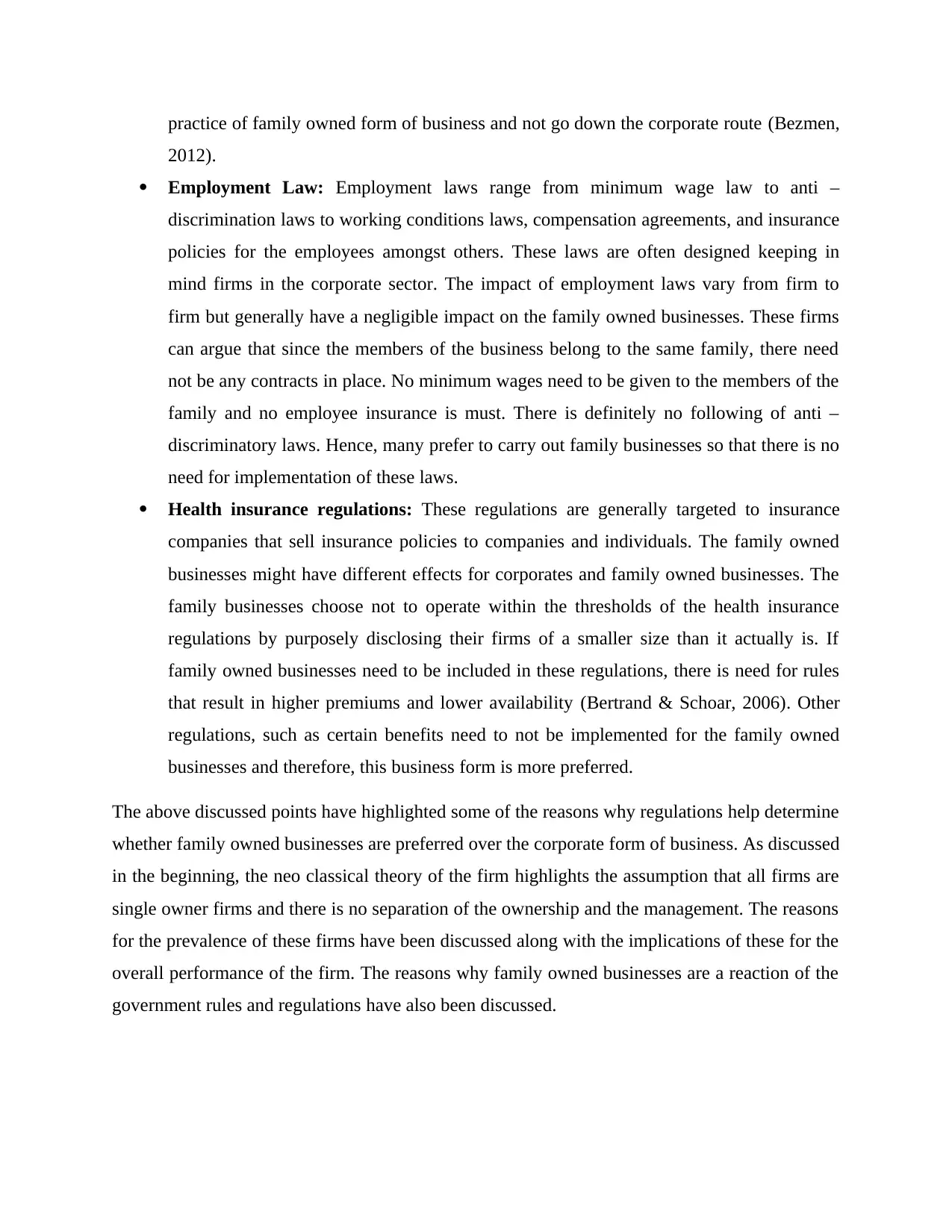
practice of family owned form of business and not go down the corporate route (Bezmen,
2012).
Employment Law: Employment laws range from minimum wage law to anti –
discrimination laws to working conditions laws, compensation agreements, and insurance
policies for the employees amongst others. These laws are often designed keeping in
mind firms in the corporate sector. The impact of employment laws vary from firm to
firm but generally have a negligible impact on the family owned businesses. These firms
can argue that since the members of the business belong to the same family, there need
not be any contracts in place. No minimum wages need to be given to the members of the
family and no employee insurance is must. There is definitely no following of anti –
discriminatory laws. Hence, many prefer to carry out family businesses so that there is no
need for implementation of these laws.
Health insurance regulations: These regulations are generally targeted to insurance
companies that sell insurance policies to companies and individuals. The family owned
businesses might have different effects for corporates and family owned businesses. The
family businesses choose not to operate within the thresholds of the health insurance
regulations by purposely disclosing their firms of a smaller size than it actually is. If
family owned businesses need to be included in these regulations, there is need for rules
that result in higher premiums and lower availability (Bertrand & Schoar, 2006). Other
regulations, such as certain benefits need to not be implemented for the family owned
businesses and therefore, this business form is more preferred.
The above discussed points have highlighted some of the reasons why regulations help determine
whether family owned businesses are preferred over the corporate form of business. As discussed
in the beginning, the neo classical theory of the firm highlights the assumption that all firms are
single owner firms and there is no separation of the ownership and the management. The reasons
for the prevalence of these firms have been discussed along with the implications of these for the
overall performance of the firm. The reasons why family owned businesses are a reaction of the
government rules and regulations have also been discussed.
2012).
Employment Law: Employment laws range from minimum wage law to anti –
discrimination laws to working conditions laws, compensation agreements, and insurance
policies for the employees amongst others. These laws are often designed keeping in
mind firms in the corporate sector. The impact of employment laws vary from firm to
firm but generally have a negligible impact on the family owned businesses. These firms
can argue that since the members of the business belong to the same family, there need
not be any contracts in place. No minimum wages need to be given to the members of the
family and no employee insurance is must. There is definitely no following of anti –
discriminatory laws. Hence, many prefer to carry out family businesses so that there is no
need for implementation of these laws.
Health insurance regulations: These regulations are generally targeted to insurance
companies that sell insurance policies to companies and individuals. The family owned
businesses might have different effects for corporates and family owned businesses. The
family businesses choose not to operate within the thresholds of the health insurance
regulations by purposely disclosing their firms of a smaller size than it actually is. If
family owned businesses need to be included in these regulations, there is need for rules
that result in higher premiums and lower availability (Bertrand & Schoar, 2006). Other
regulations, such as certain benefits need to not be implemented for the family owned
businesses and therefore, this business form is more preferred.
The above discussed points have highlighted some of the reasons why regulations help determine
whether family owned businesses are preferred over the corporate form of business. As discussed
in the beginning, the neo classical theory of the firm highlights the assumption that all firms are
single owner firms and there is no separation of the ownership and the management. The reasons
for the prevalence of these firms have been discussed along with the implications of these for the
overall performance of the firm. The reasons why family owned businesses are a reaction of the
government rules and regulations have also been discussed.
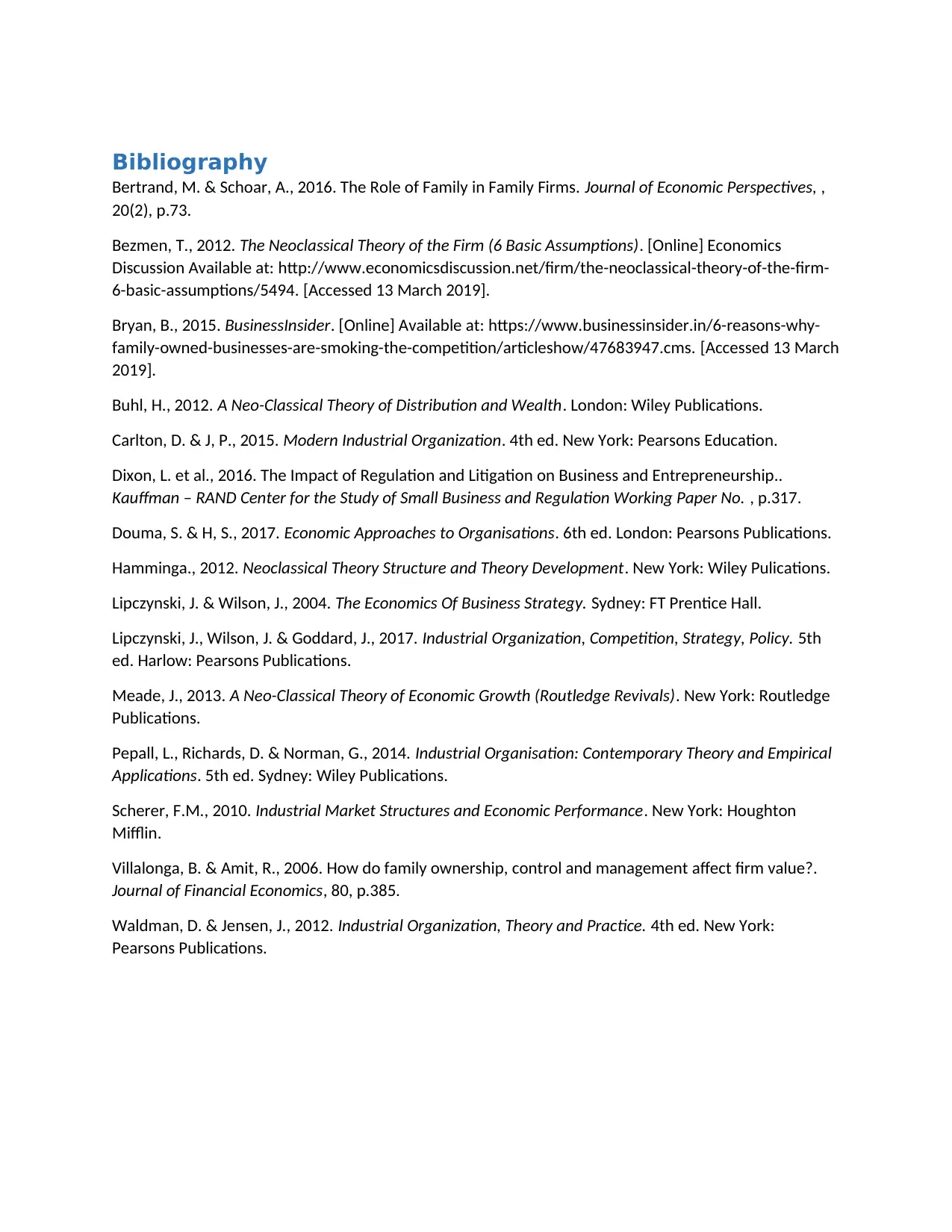
Bibliography
Bertrand, M. & Schoar, A., 2016. The Role of Family in Family Firms. Journal of Economic Perspectives, ,
20(2), p.73.
Bezmen, T., 2012. The Neoclassical Theory of the Firm (6 Basic Assumptions). [Online] Economics
Discussion Available at: http://www.economicsdiscussion.net/firm/the-neoclassical-theory-of-the-firm-
6-basic-assumptions/5494. [Accessed 13 March 2019].
Bryan, B., 2015. BusinessInsider. [Online] Available at: https://www.businessinsider.in/6-reasons-why-
family-owned-businesses-are-smoking-the-competition/articleshow/47683947.cms. [Accessed 13 March
2019].
Buhl, H., 2012. A Neo-Classical Theory of Distribution and Wealth. London: Wiley Publications.
Carlton, D. & J, P., 2015. Modern Industrial Organization. 4th ed. New York: Pearsons Education.
Dixon, L. et al., 2016. The Impact of Regulation and Litigation on Business and Entrepreneurship..
Kauffman – RAND Center for the Study of Small Business and Regulation Working Paper No. , p.317.
Douma, S. & H, S., 2017. Economic Approaches to Organisations. 6th ed. London: Pearsons Publications.
Hamminga., 2012. Neoclassical Theory Structure and Theory Development. New York: Wiley Pulications.
Lipczynski, J. & Wilson, J., 2004. The Economics Of Business Strategy. Sydney: FT Prentice Hall.
Lipczynski, J., Wilson, J. & Goddard, J., 2017. Industrial Organization, Competition, Strategy, Policy. 5th
ed. Harlow: Pearsons Publications.
Meade, J., 2013. A Neo-Classical Theory of Economic Growth (Routledge Revivals). New York: Routledge
Publications.
Pepall, L., Richards, D. & Norman, G., 2014. Industrial Organisation: Contemporary Theory and Empirical
Applications. 5th ed. Sydney: Wiley Publications.
Scherer, F.M., 2010. Industrial Market Structures and Economic Performance. New York: Houghton
Mifflin.
Villalonga, B. & Amit, R., 2006. How do family ownership, control and management affect firm value?.
Journal of Financial Economics, 80, p.385.
Waldman, D. & Jensen, J., 2012. Industrial Organization, Theory and Practice. 4th ed. New York:
Pearsons Publications.
Bertrand, M. & Schoar, A., 2016. The Role of Family in Family Firms. Journal of Economic Perspectives, ,
20(2), p.73.
Bezmen, T., 2012. The Neoclassical Theory of the Firm (6 Basic Assumptions). [Online] Economics
Discussion Available at: http://www.economicsdiscussion.net/firm/the-neoclassical-theory-of-the-firm-
6-basic-assumptions/5494. [Accessed 13 March 2019].
Bryan, B., 2015. BusinessInsider. [Online] Available at: https://www.businessinsider.in/6-reasons-why-
family-owned-businesses-are-smoking-the-competition/articleshow/47683947.cms. [Accessed 13 March
2019].
Buhl, H., 2012. A Neo-Classical Theory of Distribution and Wealth. London: Wiley Publications.
Carlton, D. & J, P., 2015. Modern Industrial Organization. 4th ed. New York: Pearsons Education.
Dixon, L. et al., 2016. The Impact of Regulation and Litigation on Business and Entrepreneurship..
Kauffman – RAND Center for the Study of Small Business and Regulation Working Paper No. , p.317.
Douma, S. & H, S., 2017. Economic Approaches to Organisations. 6th ed. London: Pearsons Publications.
Hamminga., 2012. Neoclassical Theory Structure and Theory Development. New York: Wiley Pulications.
Lipczynski, J. & Wilson, J., 2004. The Economics Of Business Strategy. Sydney: FT Prentice Hall.
Lipczynski, J., Wilson, J. & Goddard, J., 2017. Industrial Organization, Competition, Strategy, Policy. 5th
ed. Harlow: Pearsons Publications.
Meade, J., 2013. A Neo-Classical Theory of Economic Growth (Routledge Revivals). New York: Routledge
Publications.
Pepall, L., Richards, D. & Norman, G., 2014. Industrial Organisation: Contemporary Theory and Empirical
Applications. 5th ed. Sydney: Wiley Publications.
Scherer, F.M., 2010. Industrial Market Structures and Economic Performance. New York: Houghton
Mifflin.
Villalonga, B. & Amit, R., 2006. How do family ownership, control and management affect firm value?.
Journal of Financial Economics, 80, p.385.
Waldman, D. & Jensen, J., 2012. Industrial Organization, Theory and Practice. 4th ed. New York:
Pearsons Publications.
⊘ This is a preview!⊘
Do you want full access?
Subscribe today to unlock all pages.

Trusted by 1+ million students worldwide
1 out of 9
Related Documents
Your All-in-One AI-Powered Toolkit for Academic Success.
+13062052269
info@desklib.com
Available 24*7 on WhatsApp / Email
![[object Object]](/_next/static/media/star-bottom.7253800d.svg)
Unlock your academic potential
Copyright © 2020–2025 A2Z Services. All Rights Reserved. Developed and managed by ZUCOL.





